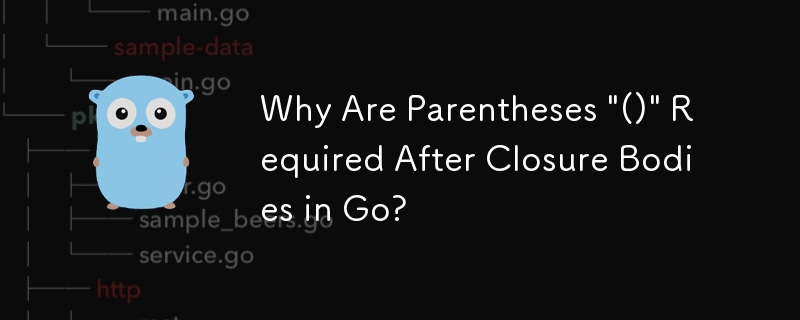Why Are Parentheses '()' Required After Closure Bodies in Go?
Dec 04, 2024 am 02:40 AM
Understanding the Purpose of "()" in Closure Bodies in Go
In Go, it is not uncommon to encounter the use of "()" after a closure body, both in function literals and defer statements. This is due to the specific requirements of the language's syntax.
Function Literals
In function literals, such as the one used in the example provided, the "()" serves to invoke the function immediately. This is necessary because the function specified in the closure is not being assigned to a variable. Instead, it is being executed directly. The "()" allows the compiler to evaluate the function and return its result.
Defer Statements
In the context of defer statements, the "()" is required because the Go specification dictates that the expression following a defer statement must always be a function call. This ensures that the function associated with the defer is executed when the function containing it returns. The "()" executes the function closure immediately, allowing it to be registered for execution when the defer is triggered.
Implications and Usage
It is important to note that the use of "()" does not specify that the function closure is a closure in itself. Closures in Go are created when a function is declared within another function and captures variables from the enclosing scope. The "()" after a closure body simply invokes the function immediately, while the defining nature of the closure lies in the presence of variable captures.
Example
To illustrate the difference between invoking a function and invoking a closure, consider the following example:
// Invoke a function immediately
func printA() {
fmt.Println("A")
}
printA()
// Create a closure and invoke it later
func createClosure() func() {
a := 1
return func() {
fmt.Println("A:", a)
}
}
closure := createClosure()
closure()In this example, the first printA() call invokes the function immediately, whereas the second call invokes a closure that captures the variable a from the enclosing scope. This distinction is crucial for understanding how closures work in Go.
The above is the detailed content of Why Are Parentheses '()' Required After Closure Bodies in Go?. For more information, please follow other related articles on the PHP Chinese website!

Hot Article

Hot tools Tags

Hot Article

Hot Article Tags

Notepad++7.3.1
Easy-to-use and free code editor

SublimeText3 Chinese version
Chinese version, very easy to use

Zend Studio 13.0.1
Powerful PHP integrated development environment

Dreamweaver CS6
Visual web development tools

SublimeText3 Mac version
God-level code editing software (SublimeText3)

Hot Topics
 Go language pack import: What is the difference between underscore and without underscore?
Mar 03, 2025 pm 05:17 PM
Go language pack import: What is the difference between underscore and without underscore?
Mar 03, 2025 pm 05:17 PM
Go language pack import: What is the difference between underscore and without underscore?
 How to implement short-term information transfer between pages in the Beego framework?
Mar 03, 2025 pm 05:22 PM
How to implement short-term information transfer between pages in the Beego framework?
Mar 03, 2025 pm 05:22 PM
How to implement short-term information transfer between pages in the Beego framework?
 How do I write mock objects and stubs for testing in Go?
Mar 10, 2025 pm 05:38 PM
How do I write mock objects and stubs for testing in Go?
Mar 10, 2025 pm 05:38 PM
How do I write mock objects and stubs for testing in Go?
 How to convert MySQL query result List into a custom structure slice in Go language?
Mar 03, 2025 pm 05:18 PM
How to convert MySQL query result List into a custom structure slice in Go language?
Mar 03, 2025 pm 05:18 PM
How to convert MySQL query result List into a custom structure slice in Go language?
 How can I define custom type constraints for generics in Go?
Mar 10, 2025 pm 03:20 PM
How can I define custom type constraints for generics in Go?
Mar 10, 2025 pm 03:20 PM
How can I define custom type constraints for generics in Go?
 How can I use tracing tools to understand the execution flow of my Go applications?
Mar 10, 2025 pm 05:36 PM
How can I use tracing tools to understand the execution flow of my Go applications?
Mar 10, 2025 pm 05:36 PM
How can I use tracing tools to understand the execution flow of my Go applications?
 How to write files in Go language conveniently?
Mar 03, 2025 pm 05:15 PM
How to write files in Go language conveniently?
Mar 03, 2025 pm 05:15 PM
How to write files in Go language conveniently?








